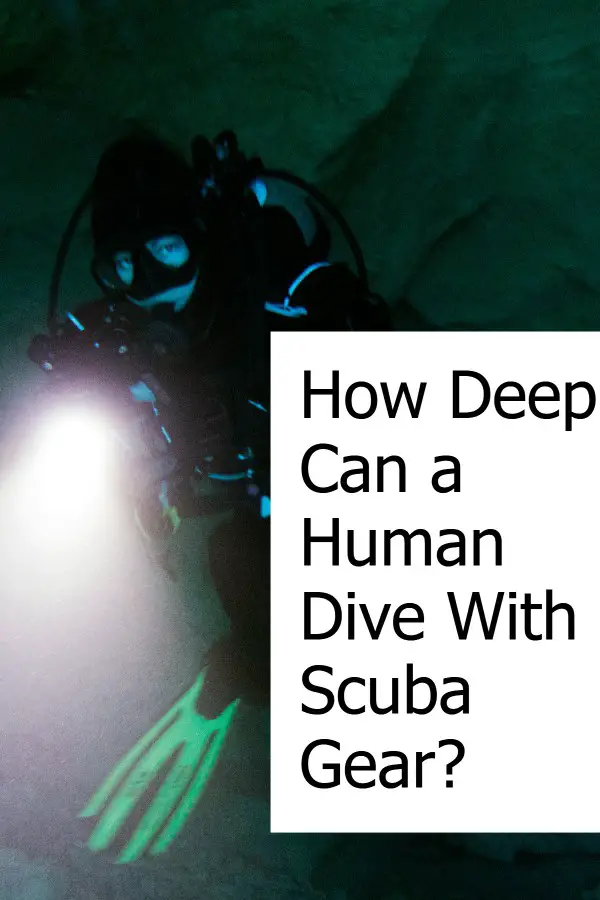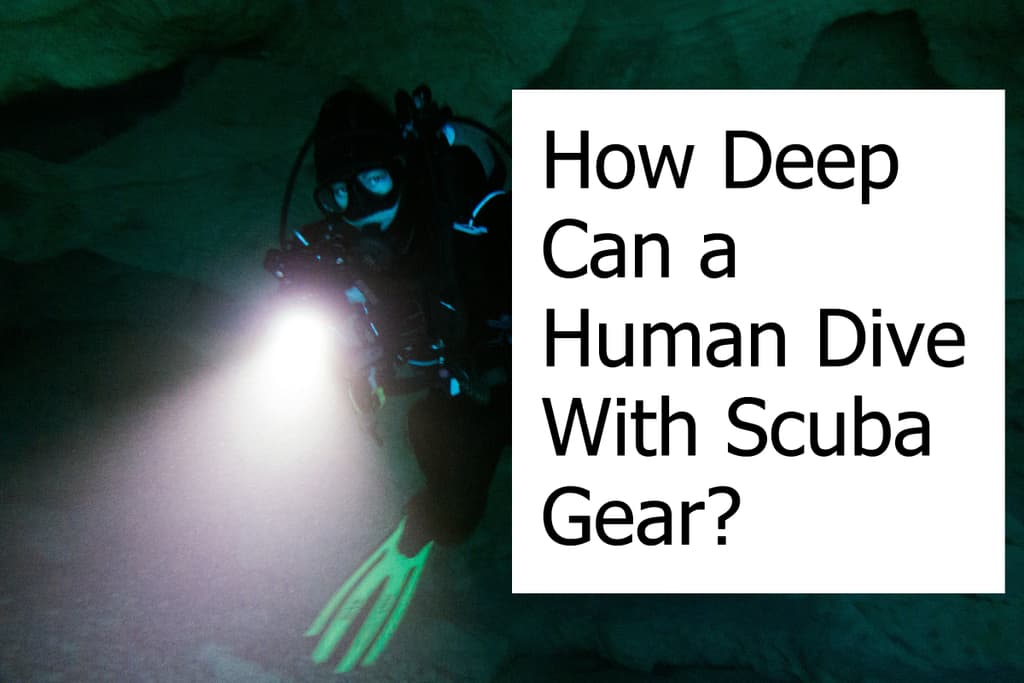How Deep Can a Human Dive With Scuba Gear?
Scuba diving is our window to catch a glimpse of the underwater world. But since the ocean isn’t our natural habitat, we can only go so deep. Even with all our scuba gear, we can’t go to the very bottom of the ocean.
Every diver needs to know how deep they can go in the ocean without risking their lives. It becomes even more important for deep divers than for beginners to have a clear understanding of the question of how deep can a human dive?
Deep diving begins at around 18 meters (roughly 60 feet), but the lower limit isn’t as easy to determine. Various factors, such as the diver’s level of expertise and air supply can alter how deep they can go.
The deepest estimated depth recreational divers can reach according to PADI (Professional Association of Diving Instructors) is around 130 feet but their time to explore is very limited as the water pressure and the intake of compressed air becomes a threat to the diver’s health. Generally, divers will have around 10 minutes to explore (How Long Do Scuba Diving Oxygen Tanks Last?) before they need to begin their ascent. The ascent has to be slow and includes stops after deep diving to prevent decompression sickness.
However, with the right gear and practice, divers can go as deep as 1000 feet and explore for a good few hours, but their ascent will be very slow since they have to make decompression stops along the way. As you can imagine there’d be no question that after such deep diving you’d end up with decompression sickness if you ascend too fast.
Diving Without Decompression
After you cross 6 meters (20 feet) underwater, it becomes necessary for divers to make decompression stops on the way up. It is crucial for the body to dispel the compressed nitrogen to avoid the risk of decompression sickness (characterized by joint pains, etc.).
What Happens to Your Body if You Dive Too Deep?
As you go deeper, the weight of the water and the buildup of compressed nitrogen start taking a toll on your body. Deep diving certainly has a largely increased risk for scuba divers.
Effects of Water Weight/Pressure
Increasing water weight/pressure starts compressing your lungs and crushing your intake of air. Your heart rate starts to diminish and your blood vessels may burst.
Deep dives put a lot of strain on the body of scuba divers and you need to be fit and train specifically to perform such deep dives without causing lasting damage to your body and organs.
Nitrogen Narcosis
The buildup of compressed air during deep diving has a laxative effect on your body. Although it feels like you’re floating, this moment of joy can kill you if you’re unable to regain control over your body and return to the surface.
The impact of nitrogen narcosis kicks in at around 100 feet. At this point, you start taking in more air to breathe, which increases your intake of compressed nitrogen. Doing a scuba dive to greater depths will increase the risk.
The nitrogen absorbs very fast into your tissues. It reaches your brain and your nervous system and can eventually make you drowsy or even unconscious. Although there is a standard cap of around 100 feet, some divers reach their limit faster and can experience the effects of nitrogen narcosis earlier, say at around 60 feet or even less.
If you start feeling drowsy during your dive, start your ascent. This will get rid of the laxative effect and by the time you return to the surface, you’ll be back to normal.
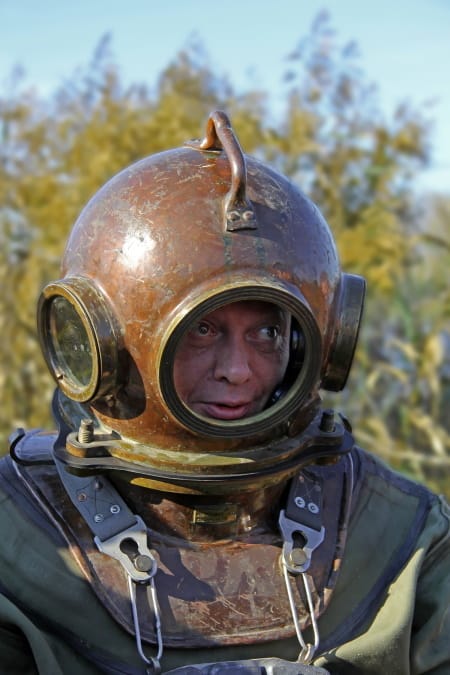
What is the Maximum Depth Anyone Has Dived to with Scuba Gear?
The maximum recorded depth any scuba diver has ever reached is around 1,090 feet. The world record for the deepest dive was set by an Egyptian, Ahmed Gabr who completed his 1,000+ feet dive in the Red Sea and it is considered to be the deepest scuba dive ever.
The diver reached the bottom in around 12 minutes and spent the remainder of the day returning to the surface. The world record dive started in the morning and ended well after midnight.
During his world record dive, the diver used up nine scuba tanks and spent 14 hours on decompression stops. He had been a professional diver for around 17 years and had spent 4 years just preparing for his record-breaking dive.
The deepest dive prior to this world record deep dive had been to a depth of around 1,044 feet.
How Deep Can Divers Go with Scuba Gear?
There are different limits set for recreational and commercial divers. With the right scuba gear including a dry dive suit, a scuba tank, gloves, and so on, divers can reach depths of around 1000 feet or more. In fact, with specialized equipment such as an atmospheric suit, divers can reach 2000 feet.
How Deep Do Recreational Divers Go?
Although some experienced recreational divers might be like the man who set the world record for the deepest dive, there are some basic depths set by dive institutions:
- Adults without any training and without scuba diving certification can go as deep as 12 meters (40 feet).
- Adults with basic open water certification can go as deep as 18 meters (60 feet).
- Advanced divers can go as deep as 40 meters (130 feet).
- Children, even those with certification can go to a maximum depth of around 12 meters (40 feet).
- Teenagers may be allowed to go to depths of around 21 meters (70 feet) if they have advanced certification.
What’s the Maximum Depth for Commercial Divers?
Commercial divers go underwater for numerous purposes:
- Construction of underwater cables and laying down pipelines. Such divers can go as deep as 200 meters (600 feet) and must perform long decompression stops to steer clear of decompression sickness. They may spend up to 12 hours or more underwater.
- Offshore diving for the construction (and maintenance) of oil or gas rigs.
- HAZMAT (HAZardous MATerials) diving to repair filters, etc. of underwater equipment to prevent serious water contamination that can be detrimental to sea creatures and humans.
- Salvaging to explore shipwrecks and sell parts for a profit.
Usually, commercial divers go to a depth of around 200-300 meters, especially if any construction or repair work is involved.
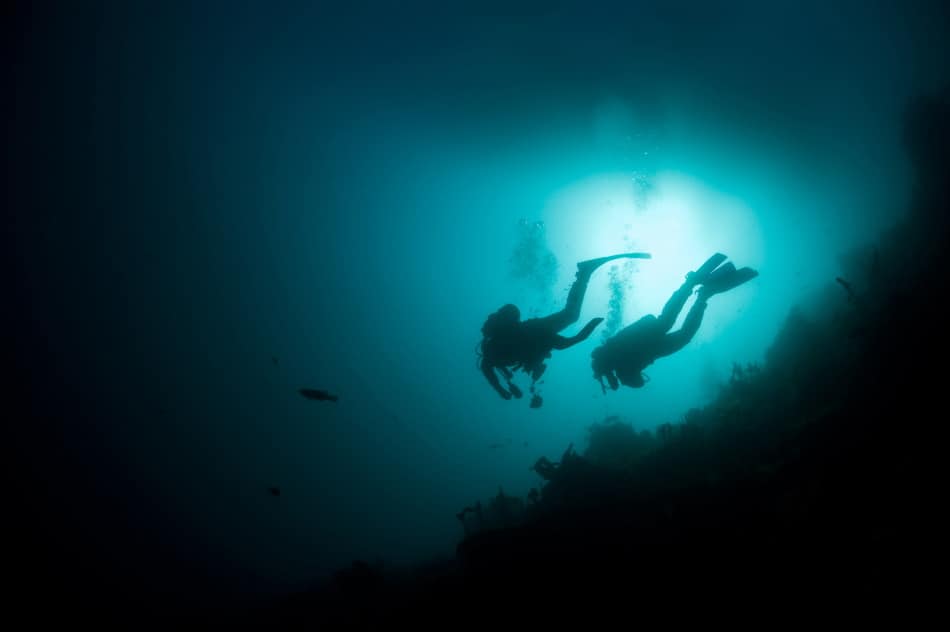
How Deep Can a Human Dive Before Being Crushed?
There is no fixed depth where we can say for sure that a diver will be crushed once they cross a certain depth. Most recreational divers don’t generally go beyond 130 feet, but commercial divers manage to reach depths of 2,000 feet with the help of atmospheric suits. There have been recreational divers who have reached a depth of 1000 feet and more and they were perfectly alright afterward.
The main thing to look out for is being crushed due to the increasing weight of the water. The water pressure can squeeze your lungs and completely constrict your breathing till you’re dead. You also run the risk of experiencing nitrogen narcosis since you will have exceeded your decompression limit.
With basic open water certification, a diver can dive to a maximum depth of 18 meters (around 60 feet). With further training, you can obtain the Advanced Open Water diving certification that will allow you to dive to a depth of 30 meters (around 100 feet).
With even more advanced training, you can go even deeper to around 40 meter (130 feet) or more. These limits are set for recreational divers, not professional and commercial divers.
To dive to such great depths, you will need to have a special mix of gases in your air supply to avoid being taken over by the narcotic effect of the compressed nitrogen.
What Gas Mixes Do You Need to Dive Really Deep?
For very deep dives, you need a special gas mix to help you breathe comfortably and combat the effects of nitrogen narcosis when you scuba dive. To reduce the amount of nitrogen in the tank, the gas mix incorporates helium or hydrogen.
The traditional mix of a scuba tank contains compressed air which is a blend of 21% oxygen and 79% nitrogen. This is only suitable till around 40 meters (130 feet). At around 56 meters (184 feet) and beyond, compressed air becomes toxic for the human body, and nitrogen narcosis sets in).
Pure oxygen tanks are rarely used by scuba divers because oxygen has a tendency to become toxic underwater and lead to oxygen toxicity. Some technical divers may use it, but they have to keep a very close eye on their decompression stops to avoid serious injuries like suffering, and potentially dying, from oxygen toxicity.
Here are some of the different types of gas mixes deep divers can make use of:
Nitrox
Nitrox mixes contain 22-40% Oxygen with the most common blends having 32-36%. However, Nitrox mixes are NOT meant for deep-diving. They are meant for shallow diving and their main purpose is to increase the decompression limit of the diver.
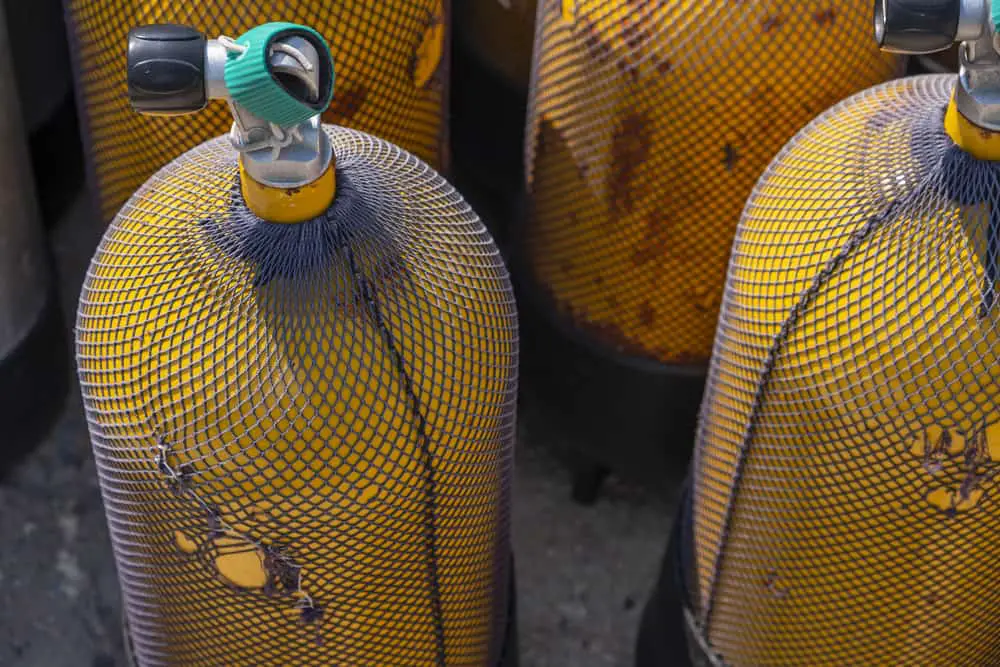
They do have a lower nitrogen content which means that your body absorbs less compressed nitrogen. The high oxygen content will still make the mix toxic once you cross the aforementioned depth.
Recreational divers start to use Nitrox more and more. One thing to remember is to have the necessary gear to deal with it. Not every dive computer can deal with Nitrox for example!
Trimix
Trimix contains a mixture of oxygen, nitrogen, and helium. We’ve already established that nitrogen has a narcotic effect on the body as we perform a deep dive, which is where the helium comes in. Helium, being an inert gas does not react with the body and allows divers to go deeper without feeling drowsy.
Trimix cylinders may contain 21% oxygen, 44% nitrogen and 35% helium (some contain 45% helium). With the trimix cylinder, divers can go as deep as 60 meters (197 feet).
If you intend to go even deeper, you need a hypoxic trimix cylinder (contains 70% helium). This will allow divers to reach around 100 meters (328 feet) without the gas supply becoming toxic.
Trimix (What do you need for a Trimix dive? What is Trimix?) cylinders are quite expensive and are generally used by technical divers that regularly perform a deep dive.
Other Mixes
Commercial divers prefer heliox over trimix when they have to do a deep dive. The heliox mix can be used for dives up to 300 meters (984 feet), but if you want to go deeper, the helium in the tank will have to be replaced with hydrogen since the helium will start having a narcotic effect.
This mix is known as hydrox and it is a combination of hydrogen and oxygen. Commercial divers such as those laying down pipelines for gas or oil rely on hydrox tanks to breathe underwater.
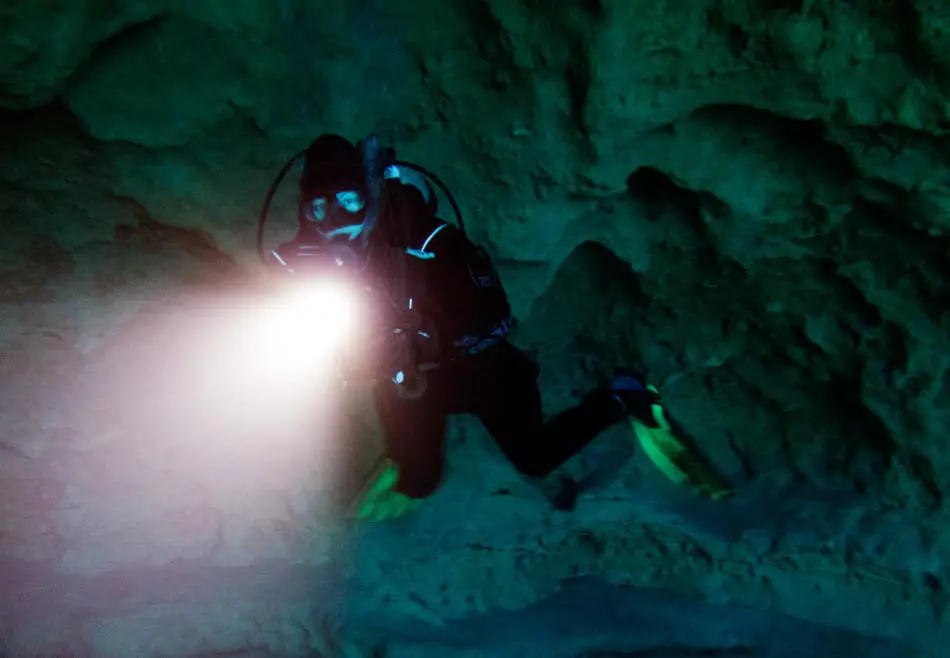
How Deep Can You Dive Without Scuba Gear?
It is highly inadvisable to dive without your scuba gear, but many daredevils and scuba enthusiasts have faced the challenge of free diving and have set world records. A professional diver managed to reach 328 feet during a diving competition!
However, we would like to point out again, that this is inadvisable. Once you reach around 300 feet, the water pressure will become so intense that it will start squeezing your lungs, slowing down your heart rate, and even shrink your blood vessels. It will even have a narcotic effect on your body, making you feel drowsy and spaced out.
A trained diver can manage such a deep dive in a short time span (around 5 minutes), but it is still very risky and not recommended.
Can You Dive Down to the Titanic?
The Titanic rests at a glorious 12,000+ feet underwater and while visits have been made to the wreckage, you can’t do a deep diving trip there. Submarine tours can take you to the ruins, but be warned, it’s not as exciting as you think. The submarine fits 5 people, has a very basic bathroom facility, and the entire journey can set you back around USD 100,000+ (if you’re going on the one-week tour)!
Even though you won’t be deep diving to the shipwreck, you still need to pass a physical fitness exam before you’re ready to make the journey. Since the most a human can dive to around 2,000 feet (and that too with a special atmosphere suit), trying a 12,000 feet dive is a death wish.
In fact, the number of people who have visited outer space is greater than those who have visited the Titanic shipwreck.
Understanding the Mystery of Saturation Diving
Saturation diving revolves around the premise that the pressure of the gas dissolved in your blood and tissues is equivalent to the gas in your lungs. If a diver reaches a depth of say, 300 feet, and stays there, the body can no longer absorb gas and reaches a saturation point. At this point, decompression stops will be the same whether the diver spends a minute or a day more underwater.
Saturation divers use a liquid mix of perfluorocarbon to breathe so that no gases get absorbed into the body. In fact, research indicates that it might be possible for humans to dive to a depth as deep as 3,000 feet with this liquid mix.
Large-scale underwater construction or repair projects are completed by saturation divers. These divers spend a few days out at sea, and when they’re not underwater, they reside in a high-pressure ship or barge.
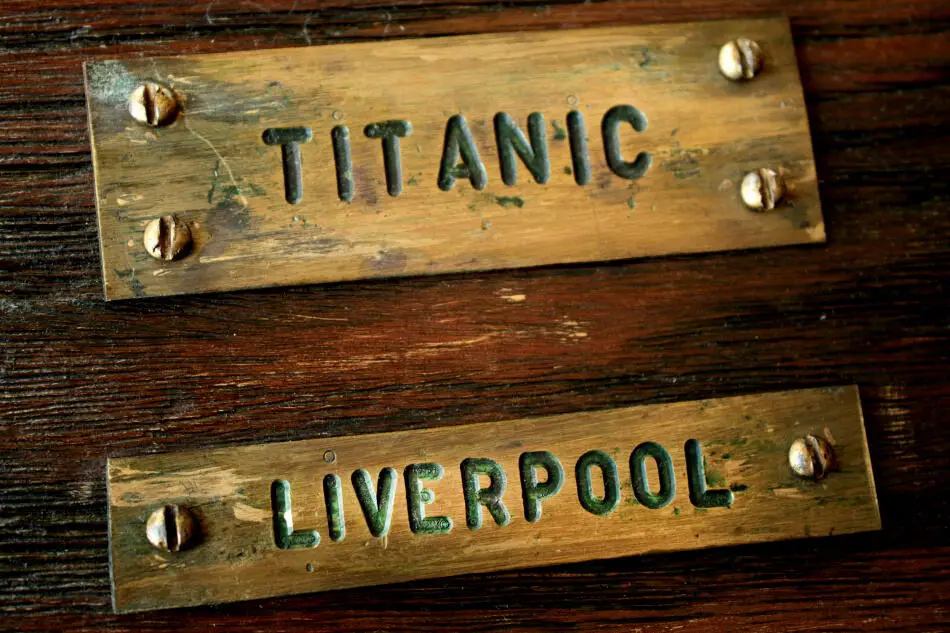
Final Thoughts
As a recreational diver, you can’t go very deep, but you can still go deep enough to explore the wonders and mysteries of the ocean. Dive institutions such as PADI provide certification for cave diving, exploring shipwrecks, and so on to enrich your diving experience.
Although commercial divers can go much deeper into the ocean, the experience eventually becomes less than magical for them. Spending a few days in a wet abyss of the ocean can take a toll on divers, physically and mentally. Deep diving might often sound more mysterious and adventurous than it really is!
If you’re ready to explore the great blue beyond, find a diving buddy, sign up for lessons and get started!
